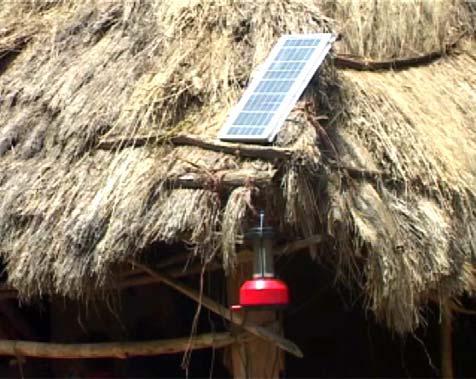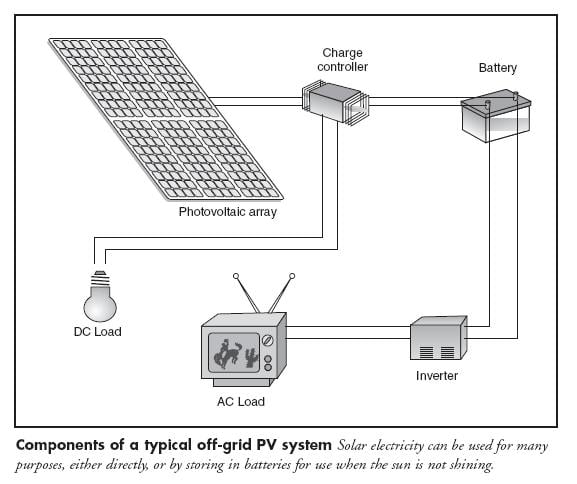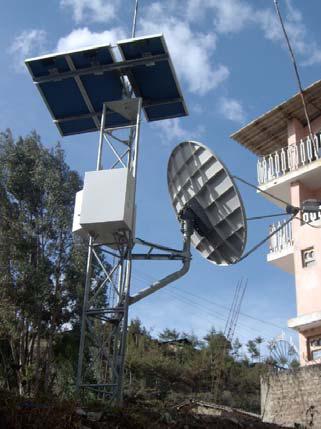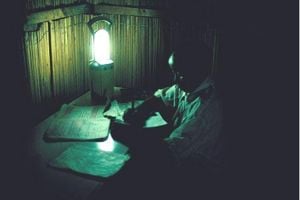Template:Checkoriginal Template:PATBpage Template:Olpc bundle
Introduction
Photovoltaic (PV) is a technology that converts sunlight directly into electricity. It was first observed in 1839 by the French scientist Becquerel who detected that when light was directed onto one side of a simple battery cell, the current generated could be increased. In the late 1950s, the space programme provided the impetus for the development of crystalline silicon solar cells; the first commercial production of PV modules for terrestrial applications began in 1953 with the introduction of automated PV production plants.

Today, PV systems have an important use in areas remote from an electricity grid where they provide power for water pumping, lighting, vaccine refrigeration, electrified livestock fencing, telecommunications and many other applications. However, with the global demand to reduce carbon dioxide emissions, PV technology is also gaining popularity as a mainstream form of electricity generation.
Several million solar PV systems are currently in use worldwide, with an installed capacity of over 6.6GW globally (2006), yet this number is a tiny proportion of the vast potential that exists for PV as an energy source.
Photovoltaic modules provide an independent, reliable electrical power source at the point of use, making it particularly suited to remote locations. However, solar PV is increasingly being used by homes and offices to provide electricity to replace or supplement grid power, often in the form of solar PV roof tiles. The daylight needed is free, but the cost of equipment can take many years before receiving any payback. However, in remote areas where grid connection is expensive, PV can be the most cost effective power source.
The use of PV electricity in developing countries
The majority of the world’s developing countries is found within the tropics and hence have ample sources of solar insolation (the total energy per unit area received from the sun). The tropical regions also benefit from having a small seasonal variation of solar insolation, even during the rainy season, which means that, unlike northern industrial countries, solar energy can be harnessed economically throughout the year.
China, India and other developing countries are emerging as major solar PV manufacturers. As of 2004, China had 70 MW of cell production capacity and 100 MW of module production capacity, compared to the world total module production capacity of 1,150 MW. India’s primary solar PV producer is Tata BP solar, which expanded production capacity from 8 MW in 2001 to 38 MW in 2004. Central Electronics, Bharat Heavy Electrical, and WEBEL Solar are other leading solar cell/module manufacturers in India. In the Philippines, Sun Power doubled its production capacity to 50 MW in 2004. In Thailand in 2004, Solartron PLC, a solar-cell module assembler, announced plans to develop the country's first commercial solar cell manufacturing facility, with annual capacity of 20 MW production from 2007.
The dominant application for PV in developing countries is the solar home system (SHS). This involves the installation of PV systems of 30 to 50 peak watts (Wp), costing about $300 to $500 (U.S.) each, in individual homes, mainly in rural areas.
Apart from SHS, other applications of PV in developing countries include 1) PV-powered remote telecommunications equipment; 2) rural health clinic refrigerators; 3) rural water pumping; solar lanterns and 4) PV battery-charging programs, which allow rural residents to purchase or rent batteries to provide electricity to their homes, and then recharge them at PV-powered charging stations. A few attempts have been made to establish PV-powered village power grids in developing countries, such as in Sagar ‘Solar Island’ off the cost of India (see later).
Cost of solar PV
Cost has been the major barrier to the widespread uptake of PV technology. Since 1976, costs have dropped about 20% for each doubling of installed PV capacity, or about 5%/year. Module prices have fallen from $30/Wp in 1975 to close to $3/Wp today. Costs rose slightly in 2004 due to high demand (which outpaced supply) and the rising cost of silicon. There is still the expectation that the cost of PV will come down as mass production increases and technologies evolve.
Note: Cost of PV modules is usually given in terms of Peak Watt (Wp), which is the power rating of the panel at peak conditions - that is at 1kWm-2 irradiance at 25ºC.
Technical
The nature and availability of solar radiation is described in the technical brief Solar Thermal Energy. Once the solar energy has arrived it needs to be captured and this can be done using photovoltaic panels.
The PV cell, modules and arrays
When light falls on the active surface, the electrons in a solar cell become energised, in proportion to the intensity and spectral distribution (wavelength distribution) of the light. When their energy level exceeds a certain point a potential difference is established across the cell. This is then capable of driving a current through an external load.
All modern, commercial PV devices use silicon as the base material, mainly as monocrystalline or multi-crystalline cells, but more recently also in amorphous form. Other materials such as copper indium diselenide and cadmium telluride are being developed with the aim of reducing costs and improving efficiencies. A mono-crystalline silicon cell is made from a thin wafer of a high purity silicon crystal, doped with a minute quantity of boron. Phosphorus is diffused into the active surface of the wafer. At the front electrical contact is made by a metallic grid; at the back contact usually covers the whole surface. An antireflective coating is applied to the front surface. Typical cell size is about 15cms diameter. The process of producing efficient solar cells is costly due to the use of expensive pure silicon and the energy consumed, but as materials technology improves costs are slowly dropping making PV technology more attractive.
The modules in a PV array are usually first connected in series to obtain the desired voltage; the individual strings are then connected in parallel to allow the system to produce more current. They are then protected by encapsulation between glass and a tough metal, plastic or fibreglass back. This is held together by a stainless steel or aluminium frame to form a module. These modules, usually comprised of about 30 PV cells, form the basic building block of a solar array. Modules may be connected in series or parallel to increase the voltage and current, and thus achieve the required solar array characteristics that will match the load. Typical module size is 50Wp and produces direct current electricity at 12V (for battery charging for example). Commercially available modules fall into three types based on the solar cells used.
• Mono-crystalline cell modules. The highest cell efficiencies of around 15%-18% are
obtained with these modules. The cells are cut from a mono-crystalline silicon
crystal.
• Multi-crystalline cell modules. The cell manufacturing process is lower in cost but
cell efficiencies of only around 15% are achieved. A multi-crystalline cell is cut from
a cast ingot of multi-crystalline silicon and is generally square in shape.
• Amorphous silicon modules. These are made from thin films of amorphous silicon
where efficiency is much lower (10%-12%) but the process uses less material. The
potential for cost reduction is greatest for this type and much work has been carried
out in recent years to develop amorphous silicon technology. Unlike monocrystalline
and multi-crystalline cells, with amorphous silicon there is some
degradation of power over time.
An array can vary from one or two modules with an output of 10W or less, to a vast bank of several kilowatts or even megawatts.
• Flat plate arrays are held fixed at a tilted angle and face towards the equator, are
most common. The angle of tilt should be approximately equal to the angle of
latitude for the site. A steeper angle increases the output in winter; a shallower
angle - more output in summer. It should be at least 10 degrees to allow for rain
runoff.
• Tracking arrays follow the path of the sun during the day and thus theoretically
capture more sun. However, the increased complexity and cost of the equipment
rarely makes it worthwhile.
• Mobile (portable) arrays can be of use if the equipment being operated is required in
different locations such as with some lighting systems or small irrigation pumping
systems.
Solar PV systems
While in developed countries there has been a rapid increase in grid connected PV systems, in developing countries the majority of PV systems are stand-alone off-grid systems. The off-grid systems can be used to drive a load directly; water pumping is a good example - water is pumped during the hours of sunlight and stored for use; or a battery can be used to store power for use for lighting during the evening. If a battery charging system is used then electronic control apparatus will be needed to monitor the system. All the components other than the PV module are referred to as the balance-of-system (BOS) components. The figure below shows a typical configurations for an off-grid PV system. Such systems can often be bought as kits and installed by semi-skilled labour.
For correct sizing of PV systems, the user needs to estimate the demand on the system, as well as acquiring information about the solar insolation in the area (approximations can be made if no data is readily available). It is normally assumed that for each Wp of rated power the module should provide 0.85watt hours of energy for each kWhm-2 per day of insolation (Hulscher 1994). Therefore if we consider a module rated at 200 Wp and the insolation for our site is 5 kWhm-2 per day (typical value for tropical regions), then our system will produce 850Wh per day (that is 200 x 0.85 x 5 = 850).

Some benefits of photovoltaics
• No fuel requirements - In remote areas diesel or kerosene fuel supplies are erratic
and often very expensive. The recurrent costs of operating and maintaining PV
systems are small.
• Modular design - A solar array comprises individual PV modules, which can be
connected to meet a particular demand.
• Reliability of PV modules - This has been shown to be significantly higher than that
of diesel generators.
• Easy to maintain - Operation and routine maintenance requirements are simple.
• Long life - With no moving parts and all delicate surfaces protected, modules can be
expected to provide power for 15 years or more.
• National economic benefits - Reliance on imported fuels such as coal and oil is
reduced.
• Environmentally benign - There is no pollution through the use of a PV system - nor
is there any heat or noise generated which could cause local discomfort. PV
systems bring great improvements in the domestic environment when they replace
other forms of lighting - kerosene lamps, for example.
PV applications in lesser developed countries
Rural electrification
• lighting and power supplies for remote building (mosques, churches, temples etc
farms, schools, mountain refuge huts) - low wattage fluorescent or LED lighting is
recommended
• power supplies for remote villages
• street lighting
• individual house systems (solar home systems)
• battery charging
• mini grids
See the Practical Action Technical Brief Rural Lighting
Water pumping and treatment systems
• pumping for drinking water
• pumping for irrigation
• dewatering and drainage
• ice production
• saltwater desalination systems
• water purification
See the Practical Action Technical Brief Solar PV Waterpumping
Health care systems
• lighting in rural clinics
• UHF transceivers between health centres
• vaccine refrigeration
• ice pack freezing for vaccine carriers
• sterilises
• blood storage refrigerators
PV is frequently used to power vaccine refrigeration in remote health centres. See the Practical Action Technical Brief Solar Photovoltaic Refrigeration of Vaccines.

Communications
• radio repeaters
• remote TV and radio receivers
• remote weather measuring
• mobile radios
• rural telephone kiosks
• data acquisition and transmission (for
example, river levels and seismographs)
Transport aids
• road sign lighting
• railway crossings and signals
• hazard and warning lights
• navigation buoys
• road markers
Security systems
• security lighting
• remote alarm system
• electric fences
Miscellaneous
• ventilation systems
• pumping and automated feeding systems on
fish farms
• solar water heater circulation pumps
• boat / ship power
• vehicle battery trickle chargers
• earthquake monitoring systems
• emergency power for disaster relief
Other issues
Local assembly of PV modules and BOS components
While generally it is only the larger developing countries which have capacity to manufacture solar cells, it is increasingly common for assembly of the module and the balance of system (BOS) components in many developing countries. This not only reduces the over all cost of syste, but creates local employment and ensures that the systems are designed for local applications.
—
| Solar co-operative for Bangladeshi women
The consultancy Prokaushali Sangsad Limited (PSL) realised the need for both quality lighting and employment for unskilled women on the remote island of Char Montaz in Bangladesh. They set up the Coastal Electrification and Women's Development Co-operative (CEWDC). The 35 co-operative members assemble and sell photovoltaic solar home systems (SHS) to island families, and also run a battery charging service. Solar home systems (SHS) are small, stand-alone electrical systems. They consist of a photovoltaic (PV) module; a re-chargeable battery; a charge controller, which prevents the battery from being over-charged or deep-discharged; fluorescent lamps rated from 6 to 11 W; wiring and fixtures. The PV modules, are rated at 20 to 80 Wp with 50 Wp the most popular size. A system based on a 20 Wp module can supply two or three 6 W lamps for about four hours per day: at the other end of the range, an 80Wp system can power four 8 W lamps and a black and white television set. Sources: Ashden Awards for Sustainable Developemnt |
Dissemination to remote areas
When disseminating solar PV to remote locations, it is important that there is sufficient capacity in the area to supply, install and maintain the solar systems. In addition, in lowincome areas, micro credit is an important element of a dissemination programme, to allow the cost of the system to be paid back over a period of time.
—
| Solar energy to meet basic needs in the Himalayas
Over the past 10 years pioneering project has been introducing solar technology to remote and inaccessible villages in the Himalayas. Run by the Barefoot College in Rajasthan, India, the project has shown that with appropriate training, poor and rural communities can install solar equipment in their villages and then maintain it without any further external help. The project has trained illiterate and semi-literate villagers as 'Barefoot Solar Engineers', (BSEs) at its Barefoot College. After the training, they return to their home villages to install solar units and provide their communities with a skilled and competent repair and maintenance service. Source: Ashden Trust Awards for Sustainable Energy |
Hybrid systems
Solar PV systems can be used in conjunction with other energy technologies to provide an integrated, flexible system for remote power generation. These systems are referred to as hybrid systems. Common configurations of hybrid systems could include a solar PV array, wind generator and diesel generator set which would allow generation in all weather conditions. Such systems need careful planning.
Solar lanterns
A new innovation is the solar lantern. Originally designed for the outdoor leisure market in western countries, this simple lantern with a small PV module (5 - 10 watts) is extremely appropriate to use in rural areas of developing countries for replacing kerosene lamps.
—
| Glowstar - Kenya
The Solar Lantern, "GLOWSTAR" has been designed as a low-cost alternative to a Solar Home System and is intended to allow rural families in Kenya to climb the first step on the "energy ladder". The lantern is cheap to maintain and harnesses a free and plentiful source of energy as it is powered by sunshine. The solar lantern kit consists of a Photo-Voltaic panel, and a lantern containing a high efficiency lamp, a rechargeable battery and a charge control circuit. The solar lantern is ideal for any application where there is no local connection to grid electricity such as rural households and farms, schools and colleges, hospitals, health clinics and other community centres. It also has important applications where there is an inconsistent or unreliable supply of electricity. Source: Practical Action Consultants. |

LED lighting
In recent years solar PV has been coupled with Light Emitting Diodes (LEDs) to provide energy efficient light. Recent advancements in LED technology have led to the development of white light emitting diodes (WLEDs). WLEDs provide a bright white light that’s ideal for domestic lighting. The advantage of using LEDs with solar PV systems is that the LED requires a much lower wattage (less than conventional high efficiency light bulbs), therefore the size and the cost of the solar system is much reduced for each household.
Micro grids
Solar PV can be used for providing power for small grid systems, with centralised power generation. As the cost of PV cell production drops, their use for medium scale electricity production is being adopted more widely. There is also scope for large-scale electricity production for such applications as peak power provision.
—
| Sagar Island - Solar Island
Sagar Island is in the southwestern corner of the Ganges Delta, in India. The West Bengal Renewable Energy Development Agency (WBREDA) has been working on Sagar Island since 1996 to address the problem of energy supply. Since then it has set up a total of 11 small solar PV power plants, on Sagar Island and its neighbour Maushuni Island. Each plant has its own mini-grid system that distributes electric power to the surrounding villages. The grids are switched on for six hours a day, from 6pm to midnight, and are managed by cooperative societies formed by the villagers that use the power. The 11 power plants in operation supplying stable and reliable 400 / 230V, 3 phase, 50Hz power for six to seven hours a day through local distribution lines. The combined capacity of the plants is 400Kw and WBREDA estimates that a further 400Kw is needed in order to electrify all the villages in the two islands. Source: Ashden Trust Awards for Sustainable Energy |
Resources and references
• Solar PV Waterpumping Practical Action Technical Brief
• Solar PV Refrigeration of Vaccines Practical Action Technical Brief
• Rural Lighting Practical Action Technical Brief
• Batteries Practical Action Technical Brief
• Solar Electricity for Over One Billion People and Two Million Jobs by 2020. EPIA
and Greenpeace, Solar Generation IV – 2007
http://www.epia.org/fileadmin/EPIA_docs/publications/epia/EPIA_SG_IV_final.pdf
• Photovoltaics Design and Installation Manual: Renewable Energy Education for a
Sustainable Future, Solar Energy International, New Society Publishers, 2004
• Practical Handbook of Photovoltaics: Fundamentals and Applications, T. Markvart
and L. Castañer (eds), Elsevier, Oxford, 2003.
• Solar Electricity (Second Edition), Tomas Markvart (ed): Publisher: John Wiley &
son, 2000.
• The GEF Solar PV Portfolio: Emerging Experience and Lessons, Monitoring and
Evaluation Working Paper 2, E.Martinot, R. Ramankutty, F. Rittner, Global
Environment Facility, 2000, ISBN 1-884122-88-4, ISSN 1020-0894.
http://www.gefweb.org/2_Solar_PV-nocov.pdf
• A case study on private provision of photovoltaic systems in Kenya, Energy and
Development Report, Energy Services for the World’s Poor, M. Hankins, World
Bank, ESMAP, 2000, ch 11.
http://www.worldbank.org/html/fpd/esmap/energy_report2000/
• Renewable Energy Technologies. H.P. Garg, D. Gouri, and R. Gupta, Indian
Institute of technology and the British High Commission, 1997.
• Renewable Energy Technologies in Africa. S. Karekezi and T. Ranja: AFREPREN /
SEI / Zed Books, 1997.
• Rural Lighting – A guide for development workers. J.P. Louineau, M. Dicko, P.
Fraenkel, R. Barlow and V. Bokalders, IT Publications and The Stockholm
Environment Institute, 1994.
• Photovoltaic Applications in Rural Areas of the Developing World. G. Foley, World
Bank, 1995.
• Best Practices for Photovoltaic Household Electrification Programs. A. Cabraal, M.
Cosgrave-Davies and L. Schaeffer, World Bank, 1996.
Internet addresses
Solarbuzz Inc.
http://www.solarbuzz.com
Home Power Magazine
http://www.homepower.com
International Solar Energy Society
http://www.ises.org
U.S. National Centre for Photovoltaics
http://www.nrel.gov/ncpv
International Centre for Application of Solar
Energy
http://www.case.gov.au
Centre for Renewable Energy and Sustainable
Technology
http://www.crest.org
International Energy Agency Photovoltaic
Power Systems Programme
http://www.iea-pvps.org
Independent site operated by ECOFYS BV,
Utrecht, Netherlands
http://www.mysolar.com
Manufacturers/Suppliers of photovoltaic products
Note: This is a selective list of suppliers and does not imply endorsement by Practical Action.
A directory of solar system suppliers by country can be obtained on-line from Solarbuzz: http://www.solarbuzz.com/solarindex/expo.htm
Below are just a few examples of the many companies providing solar power around the world.
Animatics Ltd.
Haile Selassie Avenue, P.O. Box 72011,
Nairobi, Kenya
Tel: +254 2 210 300
Fax: +254 2 210 315
Kenital Solar Energy
Ngong Road, P.O. Box 19764, Nairobi, Kenya
Tel: +254 2 715 960
Fax: +254 2 718 959
Email: info@kenital.com
Web: http://www.kenital.com
Lotus Energy Pvt. Ltd.,
Bhatbhateni Dhunge Dhara, P.O. Box 9219,
Kathmandu, Nepal
Tel: +977 1 418 203
Fax: +977 1 412 924
Email: info@lotusenergy.com
Web: http://www.lotusenergy.com
Wisdom Light Group (P) Ltd.,
Gha/2, 178 Siphal-Kalopul, GPO Box 6921,
Kathmandu, Nepal
Tel: 977-1-377254
Fax: 977-1-377256
E mail: wisdom@mos.com.np
Web: http://www.wisdomlight.com.np
CIME Commercial S.A.,
Av. Libertadores # 757, San Isidro, Lima 27,
Peru
Tel: +511 222 6083
Fax: +511 222 6330
Ferreyros,
Av. Industrial 675-Lima, Peru
Tel: +511 336 7070
Fax: +511 336 8331
E mail: ralfaro@ferreyros.com.pe
Web: http://www.ferreyros.com.pe
Link Intertrade (Private) Ltd.,
385C Old Kotte Road, Rajagiriya, Sri Lanka
Tel: +94 1 873 211-2
Fax: +94 1 867 952
Email: intertrade@link.lk
Solar Power & Light Co. Ltd.,
10 Havelock Place, Colombo 5, Sri Lanka
Tel: +94 1 688 730
Fax: +94 1 686 307
Solarman Co.,
P.O. Box 11545, Khartoum, Sudan
Tel: +249 11 472 337
Fax: +249 11 473 138
Email: solarman29@hotmail.com
U.T.E. Group of Companies,
P.O. Box 2074, Khartoum, Sudan
Tel: +249 11 70147
Fax: +249 11 70147
Alternative Technologies Pvt. Ltd.,
3 Canald Road, Graniteside, Harare, Mash
Cent, Zimbabwe
Tel: +263 4 781 972-7
Fax: +263 4 775 264
Email: snakes@zambezi.net
Solamatics,
31 Edison Crescent, Graniteside, P.O. Box
2851, Harare, Zimbabwe
Tel: +263 4 749 930
Fax: +263 4 771 212
Email: mikem@mcdiarmid.co.zw
Solar modules
Shell Solar India
20/1, Betta Chambers
4th Cross, 5th Main
Chamarajpet
Bangalore - 560018
Telephone: +91 80 66 04874
Fax: +91 80 66 03815
Web: http://www.shell.com/solar
Ersol
Wilhelm-Wolff-Str. 23 99099 Erfurt, Germany
Tel: 49 3 61 4 42 46 - 0
Fax: 49 3 61 4 42 46 - 25
E Mail: info@ersol.de
Web: http://www.ersol.de
Sharp Photovoltaics Div
282-1 Hajikami, Shinjo-cho, Kita-Katsuragigun,
Nara Prefecture 639-2198, Japan
Tel: +81 745 - 63 35 63
Fax: +81 745 - 63 35 87
Email: webmaster@sharp.co.jp
Web: http://www.sharp.co.jp
Photowatt International SA (Part of Matrix
Solar Technologies Inc.)
33 rue St. Honore, Z.I. Champfleuri, 38300
Bourgoin Jallieu, France
Tel: +33 (0)474 93 80 20
Fax: +33 (0)474 93 80 40
Email: marketing@photowatt.com
Web: http://www.matrixsolar.com
BP Solar Headquarters
630 Solarex Court Frederick, Maryland 21703,
USA USA
Tel: +1 301 698 4200
Web: http://www.bpsolar.com
Central Electronics Ltd. (CEL)
4 Industrial Area, Sahibabad, Uttar Pradesh
201010, India.
Tel: 91 120 2895165
Fax: 91 120 2895148
Email: cel@celsolar.com
Web: http://www.celsolar.com
Bharat Heavy Electricals Ltd. (BHEL)
BHEL House, Siri Fort, New Delhi - 110049,
India.
Fax +91 11 26493021; +91 11 26492534
Tel : +91 11 26001010 (multiple lines)
Email: query@bhel.com
Web: http://www.bhel.com
—
| Practical Action The Schumacher Centre for Technology and Development |